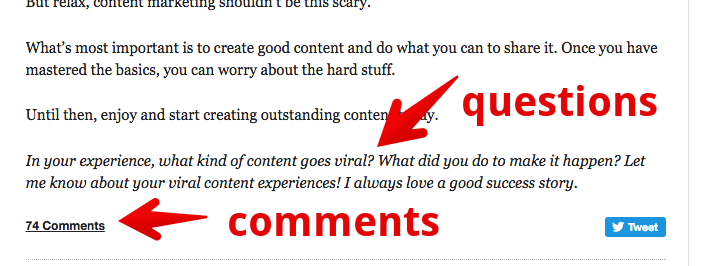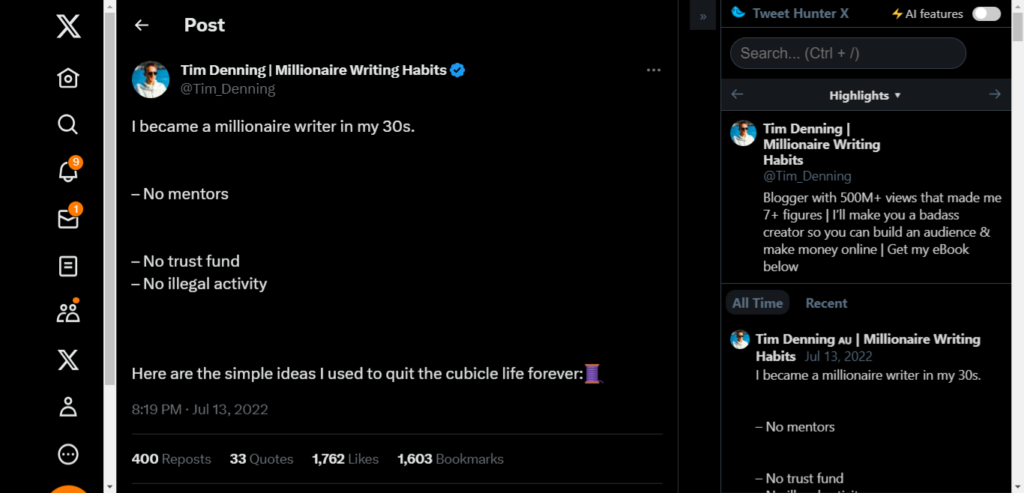You’ve just poured your heart and soul into creating an epic blog post your audience will love.
You’ve clicked the “Publish” button… Now what?
It’s tempting to move straight to the next idea—more blogs to write, more topics to cover, more content to ship, right?
Hold on.
Hitting publish is only halftime. If you immediately jump to the next piece, you leave reach, engagement, and rankings on the table.
If you want more exposure and circulation from every post, work through these 14 tactics that consistently deliver.
1. Reread the final product
Obvious? Sure. Skipped? All the time.

We’re thorough with proofreading and usually catch spelling, grammar, and style issues.
But even with care, stray errors and formatting hiccups sneak through once a draft becomes a published page.
It’s not just typos—misplaced headings, inconsistent capitalization, broken line breaks, awkward subheads, and odd image alignment can slip past you.
Use built-in spell check or a tool like Grammarly, but remember: nothing beats a human edit with a clear checklist.
Most pros have a process they follow when proofreading a document.
If proofreading isn’t your strength, try this:
- Hire a proofreader from Upwork or Fiverr—and give them a style guide (brand voice, capitalization, number formatting).
- Ask a teammate to edit with “track changes” and comments so you can learn from the fixes.
- Let the draft cool for 24–48 hours, then proof with fresh eyes. Read aloud and check the post on mobile to catch flow and formatting issues.
- Proof it a second time focusing only on links, images, alt text, and captions.
- Then a third pass just for headings, subheadings, and spacing.
- And a fourth skim for voice and clarity—swap jargon for plain language.
You may even want a copy editor instead of a proofreader.
What’s a copy editor? They go beyond grammar to improve structure, tone, clarity, and accuracy.
A strong copy editor will tighten sentences, keep the voice on brand, and spot gaps where examples or data would help.
No amount of promotion can save a post that reads sloppy. Tighten it first.
2. Insert a link to new content on old posts
Internal links pull double duty.
They keep readers moving through your site and help search engines understand how pages relate, distributing authority to the new post.
Each time we publish, we hunt for relevant evergreen posts and add descriptive, contextual links pointing to the new article.
Why this matters:
- Improves site structure and topic clustering.
- Strengthens the authority of related pages and category hubs.
- Gives the new post immediate discovery paths from existing traffic.
- Builds the page’s link profile with natural anchors.
- Signals freshness when older posts are updated with new references.
How to do it in minutes:
- Open a relevant older article (start with your highest-traffic evergreen pages).
- Find a sentence where the new post adds depth. Add a descriptive text link (avoid “click here”).
- Add the link to the new page. Update the publish date if appropriate and resubmit the page in Search Console.
Links still move the needle.
Google’s own guidance and public statements continue to emphasize internal linking for discovery, context, and prioritization—John Mueller has called internal links “super critical for SEO.”
Internal links aren’t “external,” but they clarify hierarchy and help pages get crawled, understood, and ranked.
There’s also a freshness angle—new links to a page can signal renewed relevance, which can help performance in SERPs.

Bottom line: make internal linking part of your post-publish checklist.
3. Add a question to spark discussion
Most audiences need a nudge to comment.
End with an open-ended question or prompt (“What did we miss?” “Which tactic worked for you?”). Better yet, ask for a specific example readers can share.
Questions increase time on page, encourage thoughtful replies, and give you feedback for updates and future posts.
We don’t expect everyone to answer. The point is to invite conversation.
And it works. Readers jump in—and those threads build trust and community.

4. Post on Facebook
“Duh,” but do it well.
When you share, add a one-to-two sentence takeaway that explains the benefit of clicking. Pull a compelling line or stat from the post.
Always include a strong image or a native clip. Facebook continues prioritizing original content and short-form video (Reels), while rewarding meaningful interactions and penalizing spammy reposts—opt for native assets and authentic captions.
Quick wins: use a square image, write a skimmable hook, add alt text, and respond to early comments to keep the post circulating.
Power combo: photo or Reel + short takeaway + question + link (where relevant). You’ll get far better results when you pair a clean visual with clear value.
Notice how large pages like Business Insider combine images, a brief comment, and a clear link.

5. Post on X (formerly Twitter)
X limits free accounts to 280 characters; Premium subscribers can publish long-form posts up to 25,000 characters. Lead with a hook either way.
Write a post that teases the core idea, then thread key takeaways. Finish with a link or soft CTA (e.g., “full breakdown in the post”).
Tim Denning is great at this—threads that hook attention and route readers to his articles, list, and products.

Hashtags? Keep them minimal or skip them. On X, cluttered blue text reads spammy. Focus on the message, a crisp image, or a short native clip with captions.
6. Post on LinkedIn
LinkedIn is perfect for professional, industry-relevant posts and B2B topics.
If you share consistently, you’ll improve your LinkedIn engagement.
Document carousels remain a top organic format in 2026—create them by uploading a PDF via “Add document.” Pair a story-style intro with a saveable list or framework, and tag people/companies thoughtfully.
Cut the fluff, keep it practical, and publish when your audience is online. Use a few precise hashtags, not walls of them.
7. Post on Reddit
You might think Reddit is just for geeks. It’s also a traffic gold mine when you respect the culture.
Pick subreddits where your topic genuinely helps. Read the rules, use the right flair, and lead with a text post that summarizes the value before linking.
Why? Redditors are highly engaged and quick to upvote quality—and just as quick to call out self-promo.
Be ready to answer questions in the comments. That back-and-forth is where trust (and traffic) happens.
Reddit uses karma (think “reputation”). Helpful posts surface more, and low-effort promos sink fast.
If your content is thin, expect downvotes. If it’s strong, expect comments, links, and shares.
8. Share on news aggregators
Sites like Alltop collect content by topic so readers can find the good stuff fast. It’s still active and curated in 2026; depending on your niche, alternatives include Google News (Publisher Center), Techmeme, Flipboard, and Hacker News.
Submitting to the right aggregator or community can send qualified traffic and secondary links.
9. Tap into other relevant networks
Go where your audience hangs out: Pinterest boards, Instagram, TikTok, YouTube Shorts, Threads, Quora Spaces—wherever the format and community fit your topic.
The Internet is full of active Discord servers, Telegram channels, and high-signal Facebook groups.
Find your tribe, show up with value, and share content that solves their problems in the format they prefer (short video, carousel, or a tactical thread).
10. Send to email subscribers
Your list is your owned channel. Use it.
Send a concise teaser with the payoff (“you’ll learn X in 5 minutes”), add a skimmable TL;DR, and link to the full post. Segment when it makes sense so subscribers get what they care about.
Keep a steady cadence that your audience expects—daily for newsy brands, weekly or biweekly for most. Don’t blast every small update; send when there’s clear value.
11. Ask a key contact to share it
Don’t be the person who only shows up with asks.
Occasionally reach out to a high-fit contact and ask if they’ll share—because it clearly serves their audience.
Make it effortless: include a one-sentence summary, the link, and a suggested blurb. Offer to reciprocate when appropriate and thank them either way.
Always lead with value for their niche and their readers. That’s what earns the share.
Provide value for the influencer too—feedback, a quote, or data they can reference. Read this before mass-emailing your entire address book; it’ll help you do it right.
12. Respond to comments
Getting comments is hard at first, but your replies teach readers you’re listening.
We didn’t start with big threads. We earned them by answering quickly, thanking people for pushback, and updating posts when someone surfaced a better example.
Engaged replies create social proof and encourage the next reader to join in—compounding over time.
Yes, it takes time. Do it anyway. Set a 24-hour window to reply, escalate great questions into FAQs, and moderate with a light touch.
13. Comment on other blogs
Still effective when you do it with care.
Comment where your audience already reads. Add specifics, examples, or a different angle. Don’t drop links unless they genuinely help and the site allows them.
It’s about engaging with real people.

Be helpful, relevant, and consistent. That’s how you build familiarity and trust.
14. Comment on a commenter’s blog
If you’re newer, invest a little extra time in the people who are showing up for you. For platform setup, see our picks for the best blogging platforms.
Identify a few consistent commenters and visit their sites.
Find a post related to yours and leave a thoughtful comment that adds an example or resource. You’ll build goodwill and deepen relationships.
It takes time, but it boosts your reputation and likability—both critical for long-term growth and sustained readership.
Conclusion
Blogging drives leads and sales when you treat “publish” as the starting line, not the finish.
You already know publishing is a best practice. The question is: what happens next?
Next, you share it—strategically.
A blog that only churns out posts won’t earn the traffic or engagement it deserves. Distribution is part of the work.
Follow the playbook above to widen your reach, spark conversations, and nudge the right readers toward action.
These methods help you attract qualified prospects who stick around, subscribe, and convert.
If you’ve been in the “publish and leave it” habit, this is your sign to change. Work the checklist and watch your content compound.
